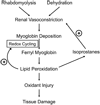Mechanism-based therapeutic approaches to rhabdomyolysis-induced renal failure
- PMID: 21034813
- PMCID: PMC3116013
- DOI: 10.1016/j.freeradbiomed.2010.10.704
Mechanism-based therapeutic approaches to rhabdomyolysis-induced renal failure
Abstract
Rhabdomyolysis-induced renal failure represents up to 15% of all cases of acute renal failure. Many studies over the past 4 decades have demonstrated that accumulation of myoglobin in the kidney is central in the mechanism leading to kidney injury. However, some discussion exists regarding the mechanism mediating this oxidant injury. Although the free-iron-catalyzed Fenton reaction has been proposed to explain the tissue injury, more recent evidence strongly suggests that the main cause of oxidant injury is myoglobin redox cycling and generation of oxidized lipids. These molecules can propagate tissue injury and cause renal vasoconstriction, two of the three main conditions associated with acute renal failure. This review presents the evidence supporting the two mechanisms of oxidative injury, describes the central role of myoglobin redox cycling in the pathology of renal failure associated with rhabdomyolysis, and discusses the value of therapeutic interventions aiming at inhibiting myoglobin redox cycling for the treatment of rhabdomyolysis-induced renal failure.
Copyright © 2010 Elsevier Inc. All rights reserved.
Figures


References
-
- Brown CV, Rhee P, Chan L, Evans K, Demetriades D, Velmahos GC. Preventing renal failure in patients with rhabdomyolysis: do bicarbonate and mannitol make a difference? J. Trauma. 2004;56:1191–1196. - PubMed
-
- Malinoski DJ, Slater MS, Mullins RJ. Crush injury and rhabdomyolysis. Crit. Care Clin. 2004;20:171–192. - PubMed
-
- Brumback RA, Feeback DL, Leech RW. Rhabdomyolysis following electrical injury. Semin. Neurol. 1995;15:329–334. - PubMed
Publication types
MeSH terms
Substances
Grants and funding
LinkOut - more resources
Full Text Sources
Miscellaneous

